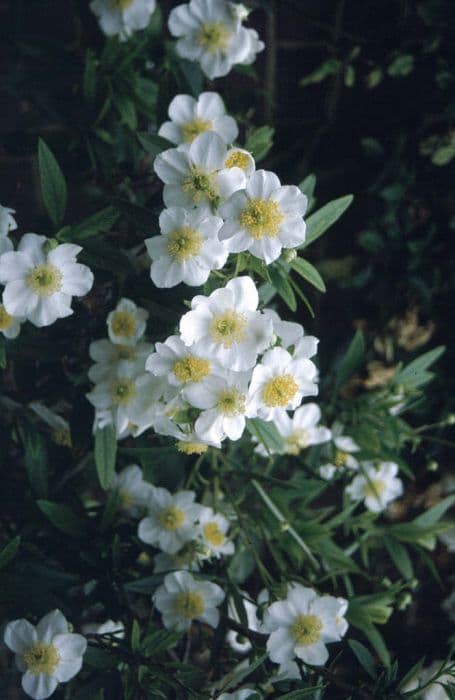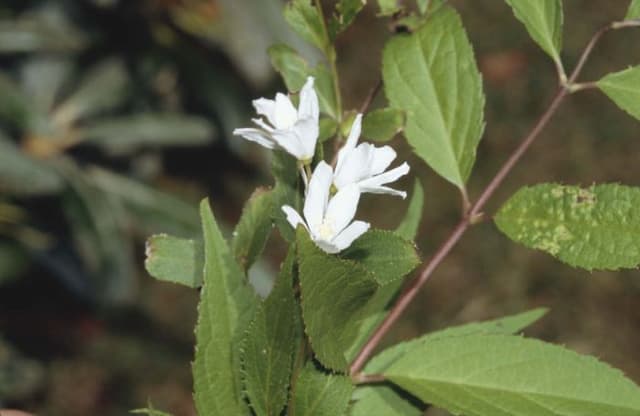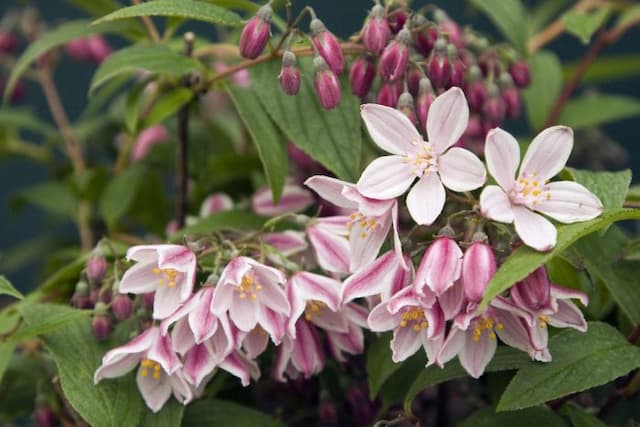Bigleaf Hydrangea Hydrangea macrophylla 'Soeur Thérèse' (H)

ABOUT
The Hydrangea, specifically the 'Soeur Thérèse' variety, is a flowering plant known for its showy blooms. This Hydrangea's flowers are typically large, rounded clusters that can be various shades, ranging from pink to blue, depending on the soil pH. The blooms consist of numerous small, starry florets that are tightly packed together, creating a lush, pompom-like appearance. The leaves of the Hydrangea 'Soeur Thérèse' are thick, ovate to broad-ovate in shape, and have a deep green color that contrasts beautifully with the blooms. These leaves often have serrated edges and can provide a rich backdrop which highlights the vivid flower heads. The overall look of the plant is lush and full, with a balance of striking flowers and robust foliage.
About this plant
 Names
NamesFamily
Hydrangeaceae
Synonyms
Bigleaf Hydrangea, French Hydrangea, Lacecap Hydrangea, Mophead Hydrangea, Penny Mac, Hortensia
Common names
Hydrangea macrophylla 'Soeur Therese'.
 Toxicity
ToxicityTo humans
Bigleaf hydrangea contains compounds that can release cyanide when digested. If parts of the plant are ingested, symptoms of poisoning can include stomach pain, nausea, vomiting, sweating, diarrhea, lethargy, and confusion. In severe cases, ingesting bigleaf hydrangea could lead to more serious symptoms such as difficulty breathing, dizziness, fainting, and a rapid pulse.
To pets
Bigleaf hydrangea is also toxic to pets. If a pet ingests this plant, they may experience symptoms such as vomiting, diarrhea, and lethargy. More serious cases of poisoning can cause depression, cyanide intoxication, and gastrointestinal obstruction. It is important to prevent pets from ingesting bigleaf hydrangea to ensure their safety.
 Characteristics
CharacteristicsLife cycle
Perennials
Foliage type
Deciduous
Color of leaves
Green
Flower color
Pink
Height
4 feet (1.22 meters)
Spread
4 feet (1.22 meters)
Plant type
Shrub
Hardiness zones
5
Native area
Japan
Benefits
 General Benefits
General Benefits- Aesthetic Appeal: Hydrangea macrophylla, commonly known as 'Soeur Therese' or simply hydrangea, offers large, showy blooms that add a burst of color to gardens and landscapes.
- Seasonal Interest: Hydrangeas generally bloom from early spring to late autumn, providing extended visual interest throughout the growing season.
- Versatile Landscaping: With their bushy growth habit, hydrangeas are suitable for a variety of landscaping uses, including hedges, borders, and as standalone specimens.
- Shade Tolerance: Hydrangeas can thrive in partial shade, making them a great option for gardens with tree cover or in areas that do not receive full sunlight.
- Soil pH Indicator: The color of the hydrangea's blooms can indicate the pH level of the soil—blue in acidic soil and pink in alkaline soil—giving gardeners a natural soil pH indicator.
- Attracts Pollinators: The flowers attract bees and butterflies, promoting pollinator health and biodiversity in the garden.
- Easy to Propagate: Hydrangeas can be easily propagated from cuttings, allowing gardeners to create new plants and expand their garden displays without additional cost.
- Cut Flower: The blooms make excellent cut flowers, with long vase life for indoor decoration.
 Medical Properties
Medical PropertiesThis plant is not used for medical purposes.
 Air-purifying Qualities
Air-purifying QualitiesThis plant is not specifically known for air purifying qualities.
 Other Uses
Other Uses- Hydrangea is sometimes used in floristry as a natural pH indicator. The color of hydrangea flowers can indicate the acidity or alkalinity of the soil—in more acidic soil, flowers will typically be blue, while in alkaline soil, they will be pink.
- Dried hydrangeas are popular in crafts and decor. Their robust blooms dry well and can be used to create beautiful wreaths, arrangements, or in dried floral displays for interior decoration.
- The plant can be used as a living fence or privacy screen in landscaping. Hydrangeas can grow quite bushy and tall, making them suitable for creating private spaces in gardens or yards.
- Hydrangea leaves and flowers can also be used to create natural dyes for fabric and paper. Depending on the preparation, a range of colors can be obtained from different plant parts.
- Pressed hydrangea flowers are often utilized in the art of flower pressing, where their vivid colors and flat nature make them ideal for framing or card making.
- In some cultures, hydrangeas have symbolic uses, such as representing heartfelt emotions or gratitude, and they are used in various ceremonies and cultural events for this reason.
- The wood of old hydrangea stems has been used in small carving projects or for making certain musical instruments due to its density.
- Botanical illustration and photography often feature hydrangeas due to their large, colorful blossoms, and are used for teaching or artistic purposes.
- As a theme in garden design, hydrangeas are frequently utilized in Cottage gardens and Victorian garden recreations due to their lush, vintage look.
- Hydrangea flowers can be used as a natural confetti at events, such as weddings or parties, as they are biodegradable and less harmful to the environment than synthetic alternatives.
Interesting Facts
 Feng Shui
Feng ShuiThe hydrangea is not used in Feng Shui practice.
 Zodiac Sign Compitability
Zodiac Sign CompitabilityThe hydrangea is not used in astrology practice.
 Plant Symbolism
Plant Symbolism- Heartfelt and Sincere Emotions: Hydrangeas are often associated with expressing genuine emotion due to their lush and full appearance. 'Soeur Thérèse', with its abundant blooms, symbolizes the overflowing nature of deep, heartfelt feelings.
- Gratitude: The lavish blooms of the hydrangea can represent thankfulness and are sometimes given as gifts to express gratitude.
- Understanding: In some cultures, hydrangeas are given as a symbol of apology or to express understanding between people, indicating a desire for deeper connection or reconciliation.
- Vanity or Frivolity: Historically, in certain contexts, hydrangeas have been thought to symbolize vanity or boastfulness due to their showy flowers, though this meaning is less common today.
- Abundance: The voluminous clusters of flowers on a hydrangea symbolize abundance and prosperity, making them a popular flower in celebrations or as gifts to wish someone well.
 Water
WaterBigleaf hydrangeas require consistent moisture and should be watered deeply once a week, providing about one to one and a half gallons of water. During hot or dry weather, increase watering to twice per week, ensuring the soil remains moist but never waterlogged. Water the plant at the base to avoid wetting the foliage, which can lead to fungal diseases. Reduce watering in the fall to prepare the plant for dormancy, and water sparingly in winter only if the soil is dry to touch.
 Light
LightBigleaf hydrangeas thrive in morning sun and afternoon shade. The best spot for these hydrangeas is one where they receive bright, indirect light for most of the day with protection from intense midday sun, which can scorch their leaves. A location on the east side of a building or under the high, dappled shade of trees would be ideal.
 Temperature
TemperatureBigleaf hydrangeas do well in a range of temperatures but prefer an average of 60 to 70°F. They can tolerate minimum temperatures down into the range of 50°F at night, and maximum temperatures up to about 80°F during the day. Protection from extreme cold is necessary, as temperatures below freezing can damage flower buds and stems.
 Pruning
PruningBigleaf hydrangeas benefit from pruning to remove dead wood and encourage new growth. Prune immediately after flowering, usually in late summer or early fall, since these hydrangeas bloom on old wood. Remove only the dead or weak stems, and try not to cut back more than one-third of the plant to ensure abundant blooms the following season.
 Cleaning
CleaningAs needed
 Soil
SoilBigleaf Hydrangeas require moist, well-draining soil rich in organic matter with a pH of about 5.5-6.5 for optimal growth. A mix of peat moss, compost, and a base of loamy soil suits them well, and amendments like pine bark can help with drainage and acidity.
 Repotting
RepottingBigleaf Hydrangeas should be repotted when they outgrow their current pot, which can be every 2-3 years. Use a larger pot to give the roots room to expand, and refresh the acidic, nutrient-rich soil mix upon repotting.
 Humidity & Misting
Humidity & MistingBigleaf Hydrangeas thrive in moderate to high humidity levels; aiming for around 50-60% relative humidity is ideal for these plants. If indoor air is too dry, using a humidifier or pebble tray can be beneficial.
 Suitable locations
Suitable locationsIndoor
Ensure bright indirect light, high humidity, and moist soil.
Outdoor
Plant in morning sun, provide shelter, and keep soil moist.
Hardiness zone
6-9 USDA
 Life cycle
Life cycleThe life of a Hydrangea macrophylla 'Soeur Thérèse', commonly known as Bigleaf Hydrangea, begins as a seed, which, when sown, will germinate in favorable conditions of warmth and moisture. The seedling emerges and develops into a young plant with leaves, and given ideal growing conditions—well-drained soil, partial shade, and adequate moisture—the plant will grow into a full-sized shrub. In the juvenile stage, the plant focuses on leaf and root expansion, usually not blooming during its first year. As it matures, typically within the second or third year, it enters the flowering stage, producing large, showy blooms that vary in color from pink to blue depending on soil pH. After the flowering period, which can last through summer and into fall, the Bigleaf Hydrangea enters a dormancy stage during winter, when the above-ground parts may die back, while the roots remain alive. With the return of spring, the plant resumes growth, beginning the cycle again with new foliage and eventually new blooms.
 Propogation
PropogationPropogation time
Spring-early summer
The most popular method for propagating Hydrangea macrophylla 'Soeur Thérèse', commonly known as mophead hydrangea, is through softwood cuttings. This process is best done during the late spring to early summer when the plant's new growth is still tender and flexible. To propagate, you'll need to take a cutting of about 5 to 6 inches (approximately 12.7 to 15.2 centimeters) long, making sure it includes several sets of leaves. Remove the lower sets of leaves, leaving one or two sets at the top of the cutting. The cut end of the stem is often dipped in a rooting hormone powder to enhance root development and then inserted into a potting mix specifically designed for cuttings. The cutting should be kept in a humid environment with indirect light until roots have formed, which typically takes a few weeks. Once rooting has occurred, the new hydrangea plant can be transplanted into its permanent location.








![Hydrangea [Strong Annabelle]](/_next/image?url=https%3A%2F%2Fplants-admin.emdemapps.com%2Fimages%2Fplants%2F%2Fimages%2F604b54db37d34.png&w=640&q=75)
